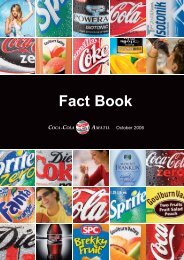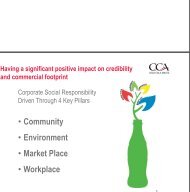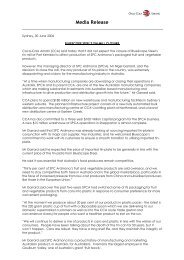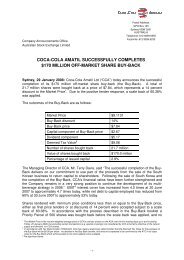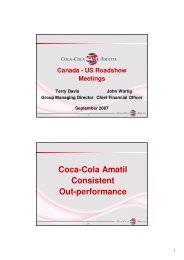2006 Sustainability Report - Coca-Cola Amatil
2006 Sustainability Report - Coca-Cola Amatil
2006 Sustainability Report - Coca-Cola Amatil
Create successful ePaper yourself
Turn your PDF publications into a flip-book with our unique Google optimized e-Paper software.
Focus on water<br />
We live in changing climate times.<br />
The world is warming, fresh water<br />
reserves are fragile and greenhouse<br />
gas emissions are taking their toll on<br />
the environment.<br />
In every country in which we operate,<br />
and particularly in the world’s driest<br />
inhabited continent, Australia, we are<br />
committed to developing better systems<br />
of managing our water resources.<br />
The vast bulk of our water use is<br />
for human consumption, as a key<br />
ingredient in most of our beverages.<br />
We have two sources of water for our<br />
drinks – mains, or “town”water for<br />
production of our soft drinks, energy<br />
drinks, juice and sports drinks and<br />
spring water, or groundwater, for our<br />
bottled water.<br />
We have two clear priorities –<br />
maintaining the long-term<br />
sustainability and quality of spring<br />
water sources and maximising mains<br />
water efficiency at our manufacturing<br />
sites. With the latter, in Australia we<br />
believe we achieve world’s best<br />
practice for our industry – on average<br />
we use just 1.55 litres of water to<br />
produce one litre of beverage (this<br />
includes all soft drinks, energy drinks,<br />
water, sports drinks and juice). Most of<br />
the water used goes into the beverage,<br />
with just over two cups per litre left to<br />
run and clean our manufacturing sites.<br />
Each year we work hard to bring this<br />
ratio down.<br />
When it comes to spring water, or<br />
groundwater, CCA believes that<br />
there needs to be urgent reform of the<br />
management of Australia’s aquifers.<br />
CCA strongly believes all groundwater<br />
users should be licensed and large<br />
users should be metered and<br />
monitored. CCA invests in<br />
infrastructure, stringent monitoring of<br />
its water use and undertakes rigorous<br />
hydrogeological studies at its water<br />
sources. Licence conditions at CCA’s<br />
water sources explicitly state that any<br />
taking of water must be sustainable.<br />
SAVING WATER AT OUR PLANTS<br />
Some of the water savings initiatives at<br />
Australian operations include:<br />
• Dry lubricant technology, based on<br />
Teflon ® suspended in a unique oil<br />
formulation, replaces water for<br />
lubrication on some of our beverage<br />
filling lines.<br />
• The machines that rinse bottles before<br />
filling are outfitted to recirculate<br />
water, and pure water is only used for<br />
the final rinsing, or the last 25% of the<br />
jets over which the bottles pass. This<br />
water is then collected and used for<br />
preliminary rinsing in the first 75% of<br />
the water jets.<br />
• Changing the size of rinser nozzles so<br />
that less water can get through. The<br />
rinser nozzles on one of Richlands’<br />
bottling lines have been changed from<br />
4mm to 2mm, resulting in a reduction<br />
of 75% of water used, or more than<br />
12 million litres (12 megalitres or<br />
12 olympic swimming pools) a year.<br />
• Recycled water from the rinsers is<br />
used on site for cooling towers, truck<br />
wash areas, floor hose down reels<br />
and irrigation.<br />
• Dual flush toilets, waterless urinals<br />
and water saving showerheads are<br />
installed across some sites, and taps<br />
fitted with aqualock flow regulators.<br />
• Water savings education programs<br />
for employees.<br />
12



